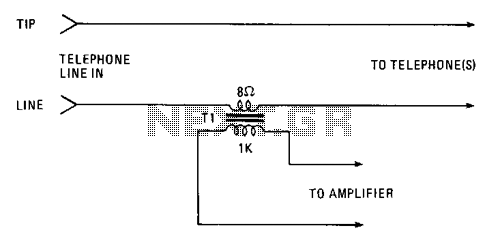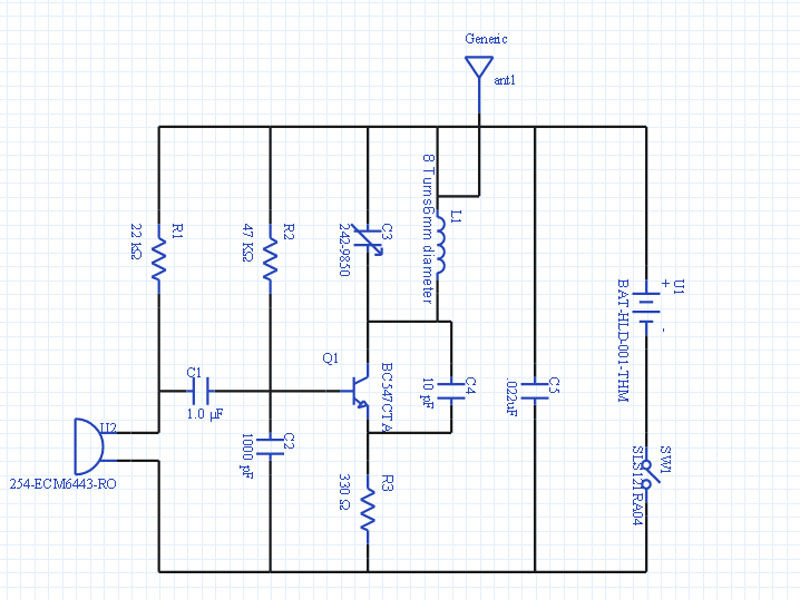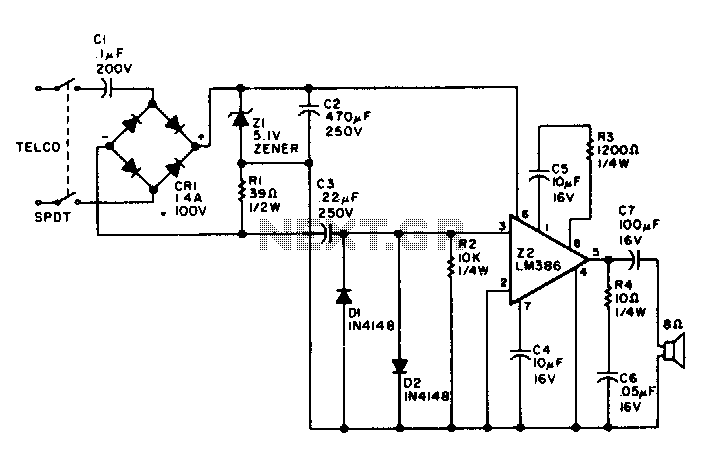
FM telephone bug

A simple telephone transmitter circuit designed for transmitting telephone conversations over short distances. This circuit is straightforward and requires only a few components. It can be easily integrated into the telephone unit or placed within a junction box. The circuit is powered directly from the telephone line. The transistor Q2 is configured as a Colpitts oscillator to generate oscillations within the FM transmission band. The audio signal from the telephone line is coupled to the base of Q2 to achieve frequency modulation. The LED D1 serves as a power-on indicator.
The telephone transmitter circuit operates by utilizing minimal components to facilitate efficient transmission of audio signals. The core of the circuit is the Colpitts oscillator, which is formed by the transistor Q2. This oscillator is crucial for generating the necessary frequency modulated signal that allows for audio transmission over radio frequencies. The configuration of the Colpitts oscillator involves a combination of capacitors and inductors that determine the oscillation frequency, ensuring it falls within the FM band suitable for communication.
The audio signal from the telephone line is effectively coupled to the base of Q2 through a coupling capacitor, which allows the variations in the audio signal to modulate the frequency of the oscillator. This modulation process is essential as it encodes the audio information onto the radio frequency carrier wave, making it possible to transmit the conversation wirelessly.
Powering the circuit directly from the telephone line simplifies the design, as it eliminates the need for an external power source. This feature enhances the circuit's practicality, especially for integration into existing telephone systems without requiring significant modifications.
The inclusion of the LED D1 as a power-on indicator provides a visual cue that the transmitter circuit is operational. This component is connected to the power supply line, ensuring that the LED illuminates when the circuit is powered, thereby confirming its readiness for use.
Overall, this simple telephone transmitter circuit exemplifies an efficient design approach for short-range audio transmission, leveraging basic electronic components to achieve effective communication capabilities.A simple telephone transmitter circuit that is ideal for transmitting the telephone conversation through small distances. The circuit is very simple and uses only few components. The entire circuit can be easily included in the telephone itself or in the junction box. The circuit is powered from the telephone line itself. The transistor Q2 is wired a s a a Colpitts oscillator to produce oscillations in the FM transmission band. The audio signal from the telephone line is coupled to the the base of Q2 to obtain the frequency modulation. The LED D1 acts as a power on indicator. 🔗 External reference
The telephone transmitter circuit operates by utilizing minimal components to facilitate efficient transmission of audio signals. The core of the circuit is the Colpitts oscillator, which is formed by the transistor Q2. This oscillator is crucial for generating the necessary frequency modulated signal that allows for audio transmission over radio frequencies. The configuration of the Colpitts oscillator involves a combination of capacitors and inductors that determine the oscillation frequency, ensuring it falls within the FM band suitable for communication.
The audio signal from the telephone line is effectively coupled to the base of Q2 through a coupling capacitor, which allows the variations in the audio signal to modulate the frequency of the oscillator. This modulation process is essential as it encodes the audio information onto the radio frequency carrier wave, making it possible to transmit the conversation wirelessly.
Powering the circuit directly from the telephone line simplifies the design, as it eliminates the need for an external power source. This feature enhances the circuit's practicality, especially for integration into existing telephone systems without requiring significant modifications.
The inclusion of the LED D1 as a power-on indicator provides a visual cue that the transmitter circuit is operational. This component is connected to the power supply line, ensuring that the LED illuminates when the circuit is powered, thereby confirming its readiness for use.
Overall, this simple telephone transmitter circuit exemplifies an efficient design approach for short-range audio transmission, leveraging basic electronic components to achieve effective communication capabilities.A simple telephone transmitter circuit that is ideal for transmitting the telephone conversation through small distances. The circuit is very simple and uses only few components. The entire circuit can be easily included in the telephone itself or in the junction box. The circuit is powered from the telephone line itself. The transistor Q2 is wired a s a a Colpitts oscillator to produce oscillations in the FM transmission band. The audio signal from the telephone line is coupled to the the base of Q2 to obtain the frequency modulation. The LED D1 acts as a power on indicator. 🔗 External reference





